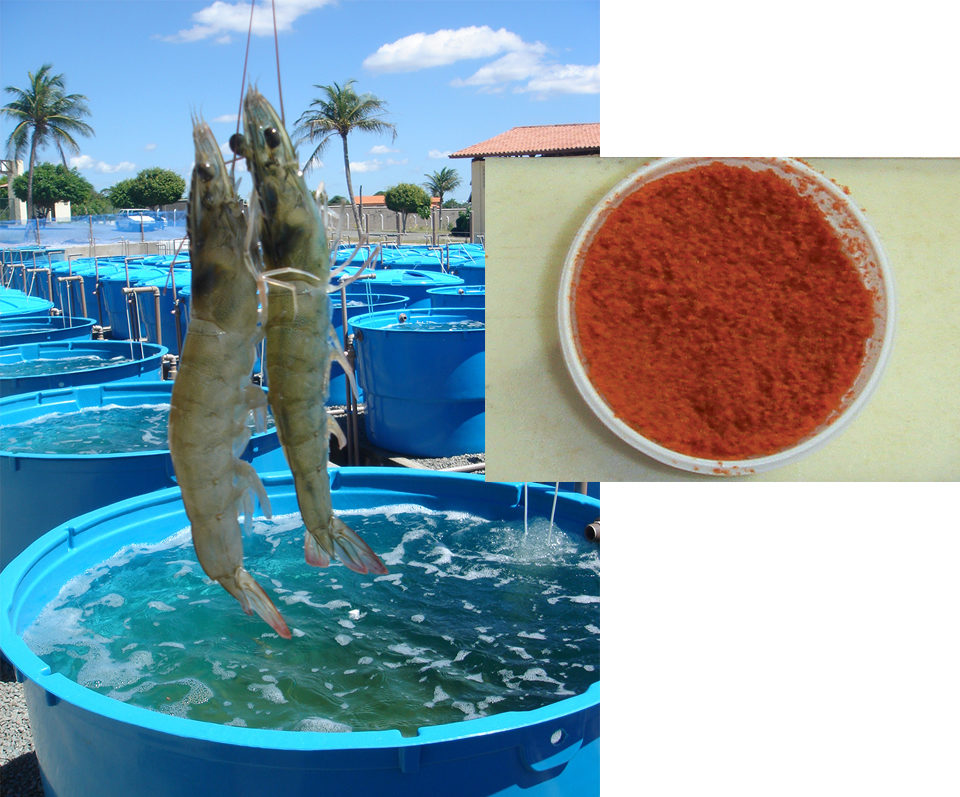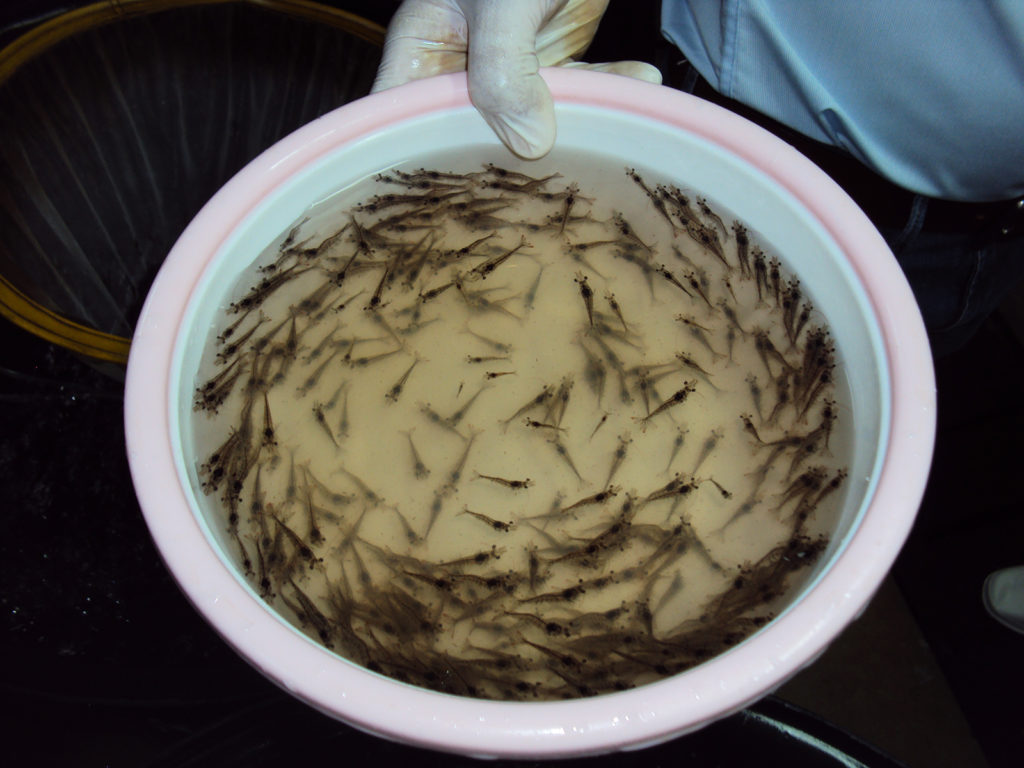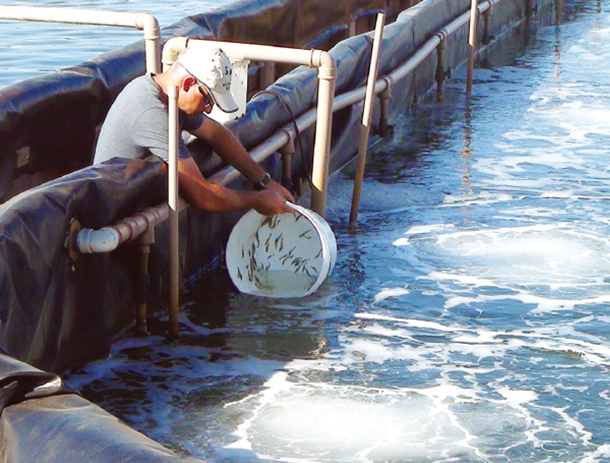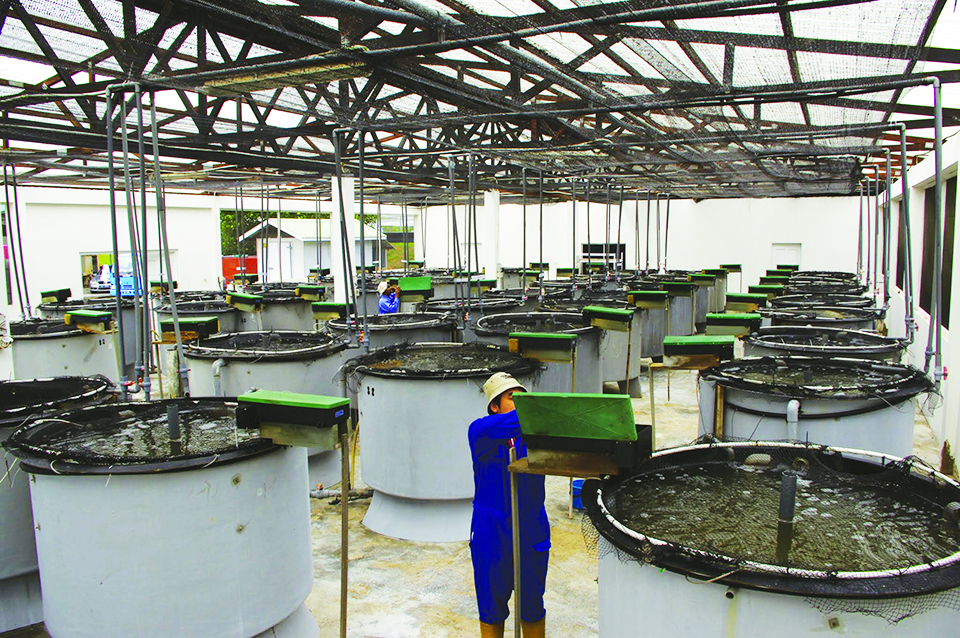Inclusion can replace fish oil, soybean lecithin and cholesterol

The search for alternative protein ingredients that can replace fishmeal in shrimp feeds has considerably increased. Despite encouraging results with plant and land animal protein sources, none has been able to surpass the individual value of fishmeal as a palatability enhancer and source of essential key nutrients.
Among the various marine animal ingredients used in aquafeeds, krill is the only resource still available in large quantities for harvest. The Antarctic krill (Euphausia superba) is a shrimp-like zooplankton practically unexploited and widely distributed in the cold waters of Antarctica. While its standing biomass ranges 400 million metric tons (MT) to 500 million MT, a precautionary catch was stipulated at 4 million MT. Fisheries currently harvest less than 0.1 million MT.
Krill meal
A typical krill meal can contain up to 65.0 percent crude protein, 22.0 percent lipid, 13.0 percent phospholipids, 0.5 percent cholesterol and 5.0 percent chitin. Due to its high fat and protein content, krill meal is rich in n-3 highly unsaturated fatty acids, with levels of sulfur amino acids superior to those of high-grade fishmeal.
Studies conducted in Australia have shown that krill meal can act as a feeding effector and growth accelerator in diets for tiger shrimp (Penaeus monodon). However, as a relatively new ingredient, little is known about krill’s potential to replace key protein and lipid sources in shrimp feeds.
Present work by the authors is evaluating the growth and economic performance of L. vannamei juveniles fed practical diets with increasing levels of Antarctic krill meal and decreasing levels of fishmeal, fish oil, cholesterol and soybean lecithin. The study was conducted simultaneously under clear and greenwater culture systems.
Brazil study
The study was conducted at LABOMAR in Brazil in 20, 500-L indoor tanks stocked at 100 shrimp per square meter and 20, 1,000-L outdoor tanks stocked at 60 shrimp per square meter. Five replicates were designated for each control and treatment feed, which were randomly assigned in both the clear and greenwater systems.
Feeds were designed with a least-cost formulation approach to achieve cost savings in treatment diets while keeping an amino acid profile similar to that of the basal diet (Table 1). Feeds consisted of a basal diet (CTL) designed to fully meet L. vannamei nutritional requirements. The CTL diet contained 187.5 grams/kg fishmeal, 20.0 grams/kg fish oil, 15.0 grams/kg soy lecithin and 1.5 grams/kg cholesterol.
Nunes, Ingredient composition and proximate chemical analysis, Table 1
| Ingredient | Diet Composition (g/kg) CLT | Diet Composition (g/kg) KM10 | Diet Composition (g/kg) KM50 | Diet Composition (g/kg) KM110 |
|---|
Ingredient | Diet Composition (g/kg) CLT | Diet Composition (g/kg) KM10 | Diet Composition (g/kg) KM50 | Diet Composition (g/kg) KM110 |
|---|---|---|---|---|
| Fishmeal, anchovy | 150.0 | 100.0 | 50.0 | 0 |
| Fishmeal, by-catch | 37.5 | 25.0 | 12.5 | 0 |
| Broken rice | 130.4 | 115.6 | 108.0 | 113.5 |
| Soybean meal | 300.0 | 340.2 | 338.6 | 349.4 |
| Meat and bone meal | 23.1 | 55.0 | 100.0 | 99.5 |
| Wheat flour | 250.0 | 250.0 | 250.0 | 250.0 |
| Fish oil | 20.0 | 15.2 | 17.7 | 0.1 |
| Soybean lecithin | 15.0 | 15.0 | 0 | 0 |
| Krill meal | 0 | 10.0 | 50.0 | 115.0 |
| Cholesterol | 1.5 | 1.5 | 0.8 | 0.0 |
| Other* | 322.5 | 322.5 | 322.5 | 322.5 |
| Savings/mt (U.S. $) | 662.8 | 8.0% | 12.8% | 8.7% |
| Proximate Composition (g/kg, dry-matter basis) | ||||
| Crude protein | 325.5 | 336.0 | 327.3 | 338.6 |
| Total lipids | 103.8 | 103.5 | 107.5 | 107.5 |
| Ash | 99.5 | 98.3 | 99.5 | 96.7 |
| Crude fiber | 1.65 | 1.49 | 1.64 | 2.22 |
| Gross energy (kJ/g) | 17.5 | 17.5 | 16.9 | 16.8 |
| Moisture (% as fed) | 11.1 | 10.7 | 10.2 | 8.8 |
* Other ingredients included 1.5 g/kg magnesium sulfate, 4.0 g/kg potassium chloride, 5.0 g/kg synthetic binder, 10.0 g/kg common salt, 10.0 g/kg vitamin-mineral premix, 12.0 g/kg bicalcium phosphate, 30.0 g/kg of corn gluten meal and 250.0 g/kg wheat flour.
From the basal diet, three other formulas were designed to progressively replace the fish products, lecithin and cholesterol with krill meal. Diets KM10, KM50 and KM110 contained krill meal at 10.0, 50.0 and 110.0 grams/kg, respectively. They also included reduced levels of fishmeal (125.0, 62.5 and 0 grams/kg, respectively), fish oil (15.2, 17.7 and 0.1 grams/kg), soybean lecithin (15.0, 0 and 0 grams/kg) and cholesterol (1.5, 0.8 and 0 grams/kg).
As these ingredients were replaced by krill meal, formula costs for the KM10, KM50 and KM110 diets decreased 8.0, 12.8 and 8.7 percent, respectively, compared to the basal diet. Animals were fed twice daily at 7:30 a.m. and 4:00 p.m. over the complete rearing period. Meals were delivered in feeding trays, allowing rough changes in feed rations at each feeding.
Results
Water quality parameters remained within ideal ranges for the culture of penaeid shrimp. In the clearwater system, water salinity reached 32.4 ± 2.6 ppt, pH was 7.72 ± 0.23, and temperature held at 27.4 ± 0.8 degrees-C. Over the rearing period, there was an increase in water salinity consistent with the dry season that takes place at the experimental site.
In the greenwater system, water salinity, pH and temperature reached 36.6 ± 3.5 ppt, 8.13 ± 0.17 and 29.6 ± 0.9 degrees-C respectively. As opposed to the clearwater system, drops in water pH in the greenwater tanks were less intense. On the other hand, water salinity peaked at 40 ppt. On average, water temperature in the greenwater tanks was 2.2 degrees-C higher than in the clearwater tanks.
After 72 days of rearing, shrimp weekly growth rates in the indoor and outdoor systems reached 1.00 ± 0.05 grams and 1.04 ± 0.09 grams, respectively. At harvest, shrimp reared in both systems showed no statistical difference in performance among treatment feeds (P > 0.05). In the indoor tanks, animals attained 13.2 ± 0.20 grams body weight, 81.4 ± 7.1 percent survival, 0.78 ± 0.12 kg per square meter yield and 2.16 ± 0.28 feed-conversion ratios (FCRs). In outdoor tanks, animals attained 14.2 ± 2.3 grams body weight, 91.3 ± 5.7 percent survival, 0.57 ± 0.07 kg per square meter yield and 2.15 ± 0.34 FCRs.
The major variation was observed in final body weight, when shrimp fed diets containing 10 to 50 grams/kg of krill meal inclusion were compared with those fed the basal and KM110 diets in the greenwater system. As these differences were not replicated under the more controlled and challenging rearing conditions of the clearwater tanks, it can be assumed they were partially the result of external factors other than krill meal use.
Rearing environment
In the present study, shrimp biological performance varied more as a result of the rearing system than in relation to feed type. At first it appeared the greenwater system imposed a greater challenge to shrimp growth. However, the clearwater tanks were intentionally deprived of natural food items and operated under a stocking density 1.7 times higher than that of the greenwater tanks.
At harvest, shrimp reared in clearwater had lower growth and survival than those in greenwater. For shrimp in clearwater tanks, yield and apparent feed intake (Table 2) were also higher, which probably led to a greater build-up of nitrogen in the rearing system. These results suggested that clearwater tanks promoted a more challenging culture environment for L. vannamei, despite the greater fluctuations in water quality observed under greenwater conditions.
Nunes, Growth response of L. vannamei juveniles fed diets containing krill meal, Table 2
| Parameter | Water | CLT | Experimental Diet KM10 | Experimental Diet KM50 | Experimental Diet KM110 |
|---|
Parameter | Water | CLT | Experimental Diet KM10 | Experimental Diet KM50 | Experimental Diet KM110 |
|---|---|---|---|---|---|
| Initial Weight (g) | Clear | 2.80 ± 0.70 | 2.90 ± 0.70 | 2.80 ± 0.60 | 3.00 ± 0.80 |
| Initial Weight (g) | Green | 3.50 ± 0.80 | 3.50 ± 0.70 | 3.50 ± 0.70 | 3.40 ± 0.80 |
| Final weight (g) | Clear | 13.10 ± 2.20 | 13.30 ± 1.90 | 12.90 ± 1.80 | 13.30 ± 2.10 |
| Final weight (g) | Green | 14.70 ± 2.10 | 13.90 ± 2.10 | 14.00 ± 2.50 | 14.20 ± 2.40 |
| Growth (g/week) | Clear | 0.98 ± 0.02 | 1.01 ± 0.07 | 0.98 ± 0.07 | 1.01 ± 0.08 |
| Growth (g/week) | Green | 1.06 ± 0.08 | 1.01 ± 0.08 | 1.02 ± 0.14 | 1.05 ± 0.07 |
| Survival (%) | Clear | 83.90 ± 10.10 | 80.00 ± 6.20 | 81.40 ± 6.90 | 80.70 ± 6.00 |
| Survival (%) | Green | 91.80 ± 4.60 | 94.40 ± 1.90 | 91.50 ± 3.60 | 85.90 ± 8.70 |
| Yield (kg/m2) | Clear | 0.80 ± 0.13 | 0.77 ± 0.14 | 0.77 ± 0.13 | 0.78 ± 0.04 |
| Yield (kg/m2) | Green | 0.58 ± 0.05 | 0.58 ± 0.04 | 0.56 ± 0.09 | 0.53 ± 0.09 |
| Apparent feed intake (kg/m2) | Clear | 1.58 ± 0.18 | 1.65 ± 0.21 | 1.66 ± 0.22 | 1.76 ± 0.14 |
| Apparent feed intake (kg/m2) | Green | 1.28 ± 0.23 | 1.12 ± 0.24 | 1.17 ± 0.12 | 1.25 ± 0.14 |
| Feed-conversion ratio | Clear | 1.99 ± 0.25 | 2.18 ± 0.37 | 2.18 ± 0.33 | 2.27 ± 0.18 |
| Feed-conversion ratio | Green | 2.47 ± 0.26 | 1.96 ± 0.10 | 2.13 ± 0.18 | 2.44 ± 0.54 |
Perspectives
Results from the present work with L. vannamei were in agreement with previous studies with fish, which also concluded that krill meal can partially replace fishmeal without unfavorable effects on growth performance and health. Although krill meal is more costly than fishmeal, its inclusion allowed reductions of other expensive ingredients – fish oil, soybean lecithin and cholesterol. Consequently, it was possible to achieve formula savings when krill meal was used without detrimental effects to shrimp growth performance.
(Editor’s Note: This article was originally published in the November/December 2010 print edition of the Global Aquaculture Advocate.)
Now that you've reached the end of the article ...
… please consider supporting GSA’s mission to advance responsible seafood practices through education, advocacy and third-party assurances. The Advocate aims to document the evolution of responsible seafood practices and share the expansive knowledge of our vast network of contributors.
By becoming a Global Seafood Alliance member, you’re ensuring that all of the pre-competitive work we do through member benefits, resources and events can continue. Individual membership costs just $50 a year.
Not a GSA member? Join us.
Authors
-
Alberto J.P. Nunes, Ph.D.
Instituto de Ciências do Mar – LABOMAR
Av. da Abolição, 3207 – Meireles
Fortaleza, Ceará, 60.165-081 Brazil -
Marcelo V.C. Sá, Ph.D.
Instituto de Ciências do Mar – LABOMAR
Av. da Abolição, 3207 – Meireles
Fortaleza, Ceará, 60.165-081 Brazil -
Hassan Sabry-Neto, M.S.
Instituto de Ciências do Mar – LABOMAR
Av. da Abolição, 3207 – Meireles
Fortaleza, Ceará, 60.165-081 Brazil
Related Posts

Aquafeeds
Animal protein meals reduce feed costs but don’t improve shrimp performance
The authors conducted a study to determine how replacement of salmon meal with various animal protein meals in feed affected the growth performance of white shrimp.

Health & Welfare
Assessment of supplemental Bacillus probiotics in whiteleg shrimp juveniles
Results of a feeding study supplementing probiotics in the diet showed that when the Bacillus species were complemented in an appropriate concentration into feeds, the growth and feed efficiency of whiteleg shrimp could be improved.

Innovation & Investment
Brazil study results encouraging for injector
Zero-exchange biofloc systems allow elevated stocking densities and production, but also require more dissolved oxygen and thorough water circulation. A new type of air injector uses only a centrifugal pump to recirculate water while naturally aspirating ambient air.

Health & Welfare
Brunei project develops technology for large black tiger shrimp production, part 4
Nutrition research run in conjunction with the breeding program ensures that cost-effective feeds are optimized for shrimp performance for a five-year project undertaken in Brunei Darussalam to develop advanced technology for production of large black tiger shrimp.


